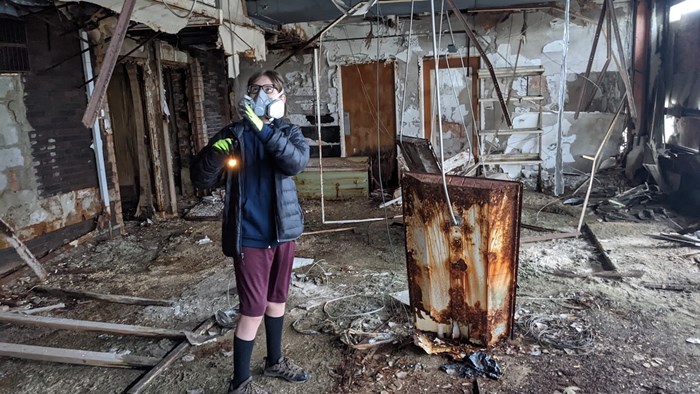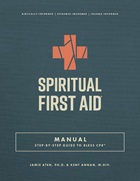The Last of Us: How an Abandoned Hospital Prompted Us to Remember Those Left Behind

My son (Henrik) and I (Ben) went urbexing a few weeks ago. Urbexing, or urban exploring, is going into abandoned buildings or areas to see what’s there. There’s a small urbexing community that seeks, explores, and reflects on the forgotten places around us. Usually, urbexing is trespassing; we hasten to add we were there with permission.
Gary was a model town at its apex in the 1960’s, with a booming economy built around what was (at that time) the world’s largest steel mill. Gary also had the distinction of pioneering a new, more scientific approach to education. Perhaps you remember the hymn of praise to the city in The Music Man: “There is only one place that can light my face, Gary Indiana, My home sweet home.” Michael Jackson, born and raised in Gary, also sang: “I’m going back to Indiana, back to where I started from.” Gary was the place to be; innovation and cultural production earned Gary the moniker “Magic City.”
Today, Gary is doubly shocking. First, to simply see its wreckage; second, to realize how bustling it once was and how far it has fallen. Gary has 13,000 abandoned buildings—30% of its total stock!
Henrik has been interested in urbexing for a while, and a few weeks ago we looked into possibilities for urbexing safely and legally. We learned Gary grants permits for entering some of the buildings, because the town has discovered there’s money to be made as the location for films with war-torn, post-apocalypse, horror, or disaster settings (think HBO’s hit “The Last of Us”). It turns out even decay can be profitable.
Hollywood sends crews to Gary for these scenes. Movies such as Transformers: Dark of the Moon (2011), A Nightmare on Elm Street (2010), and Pearl Harbor (2001) all have scenes filmed in Gary. While Gary’s licensing program is chiefly for film crews, it’s available to anyone for a fee.
Henrik and I drove to Gary the day before and stayed overnight (actually, we stayed in a nicer community nearby). The next morning, we grabbed breakfast and went shopping to gear up with goggles, masks, and flashlights. We drove to the old St. Mary’s Mercy Hospital, built in 1914 and closed in 1995, where Michael Jackson was born. Following the instructions from City Hall and clicking on our flashlights, we entered through a basement window.
We were in.
The air was cold and moist, the ground coated in a spongy mat of damp dust. I wondered what exactly made up the air my lungs were taking in. The wallpaper was torn and dangling in wide sheets.
Rusty metal. Broken windows. Fallen pipes and ducts. Insulation spilled out of gaping holes.
We found patient rooms, offices, the main reception hall, an ambulance loading bay, storage rooms, and the basement utility room. I wondered if there was a chapel, but didn’t find one.
After a couple of hours I was ready to leave, not overwhelmed as much as spent and weary: “Hey Henrik, how about it? Should we call it a day?”
Henrik wanted to keep looking for the surgery. We found it in the basement at the far end of the building.
After finishing inside, we drove around Gary to see the factories, main street, historic locations (like the settlement houses from the early 20th century), and residential neighborhoods. The settlement houses were remarkable institutions that provided educational and welfare services to immigrant, minority, and poor communities when no other institutions could or would. They popped up in rapidly urbanizing places that didn’t have the institutional network to support dense populations, and were most often founded and run by women. They were places for gathering, eating, learning, and receiving needed resources.
And the churches. Oh, the churches. Once majestic, they were now host to congregations of grasses and trees under an open sky where the roofs once were.
So what happened to Gary? The short answer: The economy in Gary needed the steel works, and the steel industry collapsed. To learn more, we spoke with sociologist Dr. Brian Miller, professor at Wheaton College: “Gary was an unusual industrial suburb or ‘satellite city’ as Taylor called them in 1915. The city grew rapidly around the steel industry.”
However, foreign competition and automation took steep tolls. In 1971 alone, more than 10,000 workers were laid off. As jobs disappeared, so did residents. Over the decades, an estimated total of 55% of Gary’s population has left, a truly astounding absence.
Dr. Miller added that race played a part too: “Additionally, the white flight of numerous white residents changed the demographics of the community. The loss of jobs and residents with higher incomes affects the tax base of communities, as well as its status.” And with population numbers falling off a cliff, institutions like St. Mary’s were also casualties.
It’s no wonder Gary hasn’t been called “Magic City” for a long time. More recently, it was dubbed the Murder Capital of the Country and Scary, Indiana.
Dr. Miller highlighted the implications of Gary’s decline for those who still live there: “Efforts to attract new businesses and development are difficult once a community has a particular reputation and limited resources.”
Finishing his thought, Dr. Miller added, “As William Julius Wilson and other scholars have argued, the conditions lead to social isolation and local adaptations to difficult economic circumstances.” I can’t help but think of the revenue stream from Hollywood when Dr. Miller says “local adaptations.” Through a twisted irony, disaster movies can help a community like Gary.
Before our trip, we talked to someone from the Gary historical society. She’s a lifelong native of Gary, and for her, Gary was not an abstract historical interest like it was for us. She remembers “Magic City” with fondness and laments what Gary has become. For her, the fact that Gary has become the go-to place for shooting horror films and dystopian dramas is devastating.
What are we carrying away from our experience? It’s not so much that places matter. We already knew that. Gary was home to tens of thousands of people; now, it’s a shell. People need healthy places, and places need people. So when a place fails, people suffer from it.
The more important lesson is how we relate to these places. It is easy to think of a place like Gary as a real-life horror movie. But St. Mary’s operated for 81 years. That’s 81 years of births and deaths, of community life, reduced to a wet pile of dust and sour smells.
Gary is more than what the movies or the ruins suggest, but it is a struggle to see past the image. The lady from the historical society helped us with this.
There’s still magic in “Magic City.”
Nowadays, there’s a new hospital, and this one is filled with the sounds of the community.
Dr. Benjamin Norquist is currently working on a joint book project about how American Christians relate to places. Follow Ben’s work.
The Better Samaritan is a part of CT's
Blog Forum. Support the work of CT.
Subscribe and get one year free.
The views of the blogger do not necessarily reflect those of Christianity Today.






















